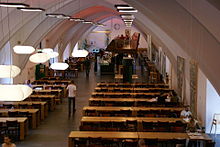Marstall (Heidelberg)
The Heidelberg Marstall , built from Neckar valley sandstone , is one of the oldest surviving buildings from the early modern period in Heidelberg .
History of origin
The Marstall with its 135-meter-long building front along the Neckar is one of the few buildings that were built at the transition from the late Middle Ages to the early modern period and that have survived the turmoil of the centuries unscathed in Heidelberg's old town to this day .
The building complex was probably built under Elector Ludwig V around 1510 as an armory and gun foundry, in preparation for war, directly on the Neckar . Only a few years earlier, in 1504, Heidelberg had been besieged in the so-called Landshut War of Succession , which possibly gave rise to the construction of the military building in the immediate vicinity of the city wall. As a competent architect takes Herbert Derwein the Palatine builder and GunMaster Lorenz Lechler on who was at the material time in Palatine services and the necessary knowledge should have exhibited both architecturally and in military terms.
At both boundaries of the building complex, along its Neckar front, there is a watchtower with loopholes for handguns .
The name Marstall, which was later given to the building, goes back to a Renaissance building along the south side of the inner courtyard, which was destroyed in 1693 during the War of the Palatinate Succession and which was built under Count Palatine Johann Casimir in 1590.
Today's use of the building
Today, the building complex, the interior of which has been redesigned several times in the course of its history, houses the award-winning armory cafeteria and the administration of the student union .
The body of the building complex and its entire architecture, made of meter-thick sandstone walls, have been preserved to this day in the original state of the time it was built. The Marstall Heidelberg, together with the Heuscheuer (Heidelberg) facing east, up the Neckar , forms an impressive ensemble made of Neckar valley sandstone, the quarries of which are largely abandoned today.
literature
- Ute Fahrbach: Marstall, Marstallstrasse and Heuscheuer in Heidelberg . Art History Institute of the University of Heidelberg 1989, DNB 944175163 .
- Richard Henk, Rudolf Schuler: Heidelberg , Braus Verlag, Heidelberg 1990, ISBN 978-3-921524-46-6 .
- Melanie Mertens, among others: Stadtkreis Heidelberg (= monument topography Federal Republic of Germany : cultural monuments in Baden-Württemberg. Volume II.5). Part 1, Jan Thorbecke, Ostfildern 2013, ISBN 978-3-7995-0426-3 , pp. 365-367.
Web links
Individual evidence
- ^ A b Herbert Derwein : On the medieval building history of Heidelberg. In: Karl Schwingel (Ed.): Festschrift for Karl Lohmeyer. West-Ost-Verlag, Saarbrücken 1954, pp. 10–13, here p. 13.
- ^ Herbert Derwein: On the medieval building history of Heidelberg. In: Karl Schwingel (Ed.): Festschrift for Karl Lohmeyer. West-Ost-Verlag, Saarbrücken 1954, pp. 10–13, here p. 11.
Coordinates: 49 ° 24 ′ 47 " N , 8 ° 42 ′ 17" E



